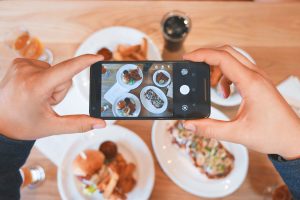Connected customer experiences: The product of a connected economy
Today’s connected consumers are more likely to show off their latest sushi dinner on Instagram than their latest possessions. They want — and immediately expect — rewarding experiences from every company they do business with. And like a virtuous cycle, their latest great experience immediately sets the bar higher for the next brand they encounter.
Welcome to the connected economy, where new forms of value are created not by selling products, but by connecting the dots between people, the internet of things and organizations.
According to Gartner, by 2020 more than 40% of data analytics projects will relate to an aspect of customer experience. For many consumer-facing industries, finding novel ways to delight customers isn’t just about growth, but survival.
Consider major credit cards, which increasingly compete for customer loyalty based on their ability to understand consumer behavior. To succeed they must connect insights from the real world and the digital world and use them to curate more personalized customer experiences. They have scores of partnerships with organizations — from airlines and hotels to insurance and car rental companies. This enables them to know you’ve been filling up your gas tank multiple times down the east coast. So they might offer you a great deal on a hotel in Florida.
Or take traditional brick-and-mortar retailers like Home Depot or Crate & Barrel that partner with XPO Logistics to deliver bulky products like barbeque grills and furniture. From the moment consumers purchase an item to when it’s delivered, they can now simply connect with Amazon’s Alexa or Google Assistant to check on their orders.
These kinds of connected customer experiences are becoming the norm. Driven by a new wave of partnerships in the connected economy, the consumer’s notion of value is changing. They’re not buying products anymore. They’re buying connected experiences.
We reached this point from a perfect storm of evolving social behavior and mainstreaming technologies like cloud, analytics, AI and mobile computing. But it’s the largely untapped potential of billions of IoT devices that holds the most promise for connected experiences.
In the wake of IoT adoption and maturing technologies, does anyone even think about computing anymore? We simply expect it to meet our changing needs and desires at every moment of our lives.
Think about it. When Uber debuted, consumers got a kick out of tracking their drivers with the app until they arrived. Now when waiting for a package delivery, they expect to track the delivery truck to their home, an experience UPS now offers.

Today’s connected consumers are more likely to show off their dinner on Instagram than their latest possessions.
To survive the connected economy, enterprises of all shapes and sizes are making connected customer experiences their new obsession. This is both a cultural and a technical challenge. Creating these new forms of value — the new “product” of the connected economy — doesn’t happen in a vacuum. It requires collaborating with other brands on experiences that are highly personalized, timely and — most importantly – delivered in precisely the right context.
That’s where IoT comes in. Joined together with other data sources, insights from IoT — from sensors in streetlights and roads to weather stations and in-store devices — provide the critical missing context behind human behavior that turn connected experiences from theoretical to practical. With the consumer’s physical and digital worlds converging (many of us no longer distinguish between the two), IoT promises to take connected experiences to a whole new level.
We’re just starting to grasp the possibilities. The latest LED streetlights equipped with sensors can capture foot traffic data. That could be used to automatically alert a city manager when a large crowd suddenly gathers at an intersection. The official could check video from a local traffic camera to see if it was caused by a traffic accident. If so, first responders could be proactively dispatched.
Retailers could cash in by connecting the dots with the same data. Local stores participating in an urban commerce ecosystem could use the same insights to invite crowds departing from a concert or sports event to a flash sale, boosting revenues for retailers and cities alike.
And suppose a water main break caused a traffic jam. What if shoppers traveling to an uptown supermarket were automatically alerted to visit the midtown store instead? Before long, consumers will expect their favorite stores to deliver these kinds of experiences, made possible through connected consumer intelligence.
Bringing IoT insights together will drive hyper-personalized experiences that precisely fit a consumer’s circumstances at any particular point in time. Without them, businesses and cities will lack the critical context to offer consumers relevant and timely offers and opportunities they expect.
Consider how the thrill of buying a new car is interrupted by applying for dealer financing. But what if your bank had the right connected insights to infer you were test driving a particular car? By pressing one button on your bank’s app, you’d have a customized financing offer in hand. And a new car in your driveway sooner.
Connected consumer intelligence will allow enterprises to create customer experiences that are so precise, timely and relevant, they’ll seem prescient. Consumers will expect positive, bespoke experiences from combining IoT insights with other diverse, real-time data sources. This will force companies in all industries to rethink their customer engagement strategy.
Before long, successful businesses will be manufacturing great connected customer experiences, putting them in a bottle and selling it. The ones that don’t will not only lose our business, but eventually their own.
All IoT Agenda network contributors are responsible for the content and accuracy of their posts. Opinions are of the writers and do not necessarily convey the thoughts of IoT Agenda.
